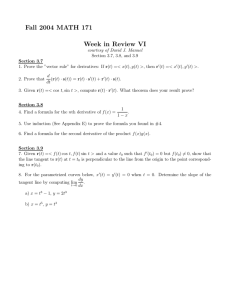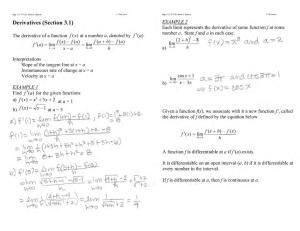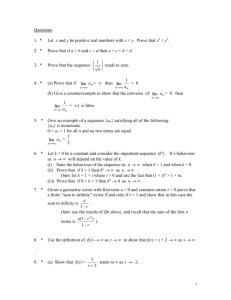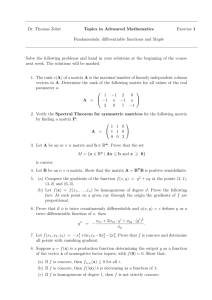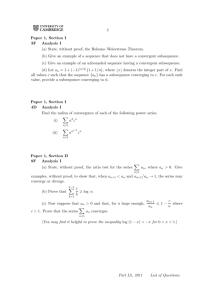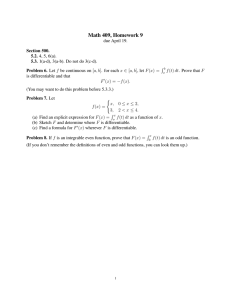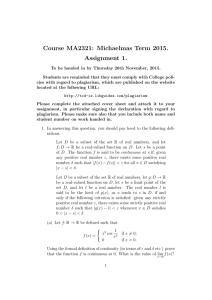Course MA2321: Michaelmas Term 2015. Assignment 2.
advertisement
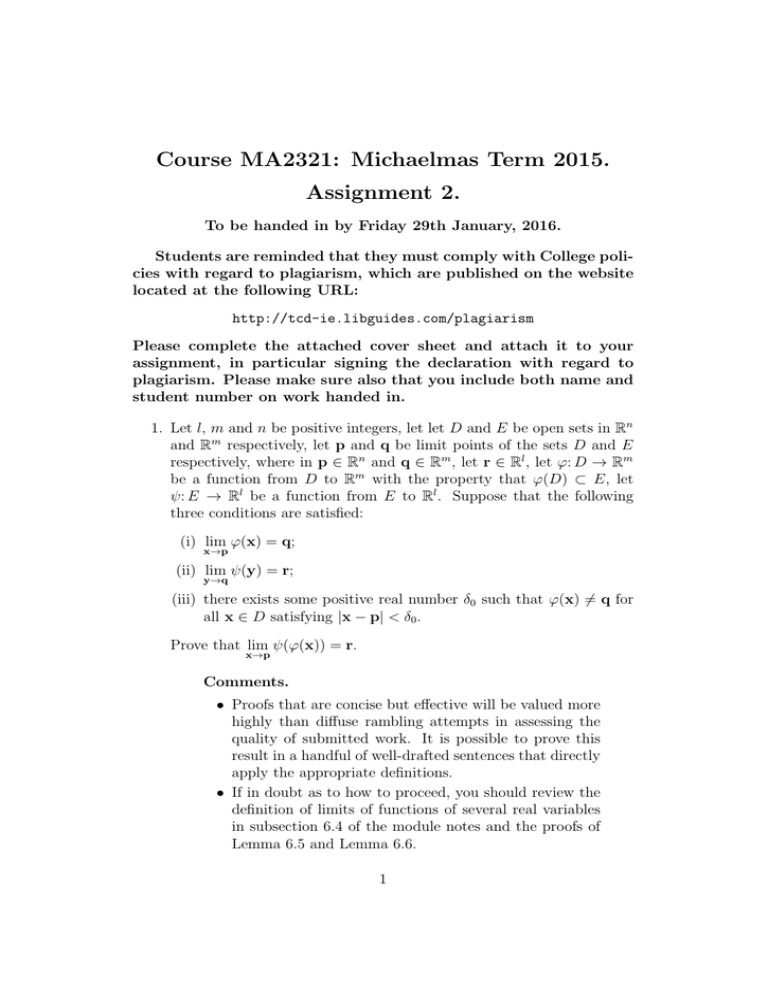
Course MA2321: Michaelmas Term 2015.
Assignment 2.
To be handed in by Friday 29th January, 2016.
Students are reminded that they must comply with College policies with regard to plagiarism, which are published on the website
located at the following URL:
http://tcd-ie.libguides.com/plagiarism
Please complete the attached cover sheet and attach it to your
assignment, in particular signing the declaration with regard to
plagiarism. Please make sure also that you include both name and
student number on work handed in.
1. Let l, m and n be positive integers, let let D and E be open sets in Rn
and Rm respectively, let p and q be limit points of the sets D and E
respectively, where in p ∈ Rn and q ∈ Rm , let r ∈ Rl , let ϕ: D → Rm
be a function from D to Rm with the property that ϕ(D) ⊂ E, let
ψ: E → Rl be a function from E to Rl . Suppose that the following
three conditions are satisfied:
(i) lim ϕ(x) = q;
x→p
(ii) lim ψ(y) = r;
y→q
(iii) there exists some positive real number δ0 such that ϕ(x) 6= q for
all x ∈ D satisfying |x − p| < δ0 .
Prove that lim ψ(ϕ(x)) = r.
x→p
Comments.
• Proofs that are concise but effective will be valued more
highly than diffuse rambling attempts in assessing the
quality of submitted work. It is possible to prove this
result in a handful of well-drafted sentences that directly
apply the appropriate definitions.
• If in doubt as to how to proceed, you should review the
definition of limits of functions of several real variables
in subsection 6.4 of the module notes and the proofs of
Lemma 6.5 and Lemma 6.6.
1
• Note that a valid proof will require all of conditions (i),
(ii) and (iii) to be satisfied.
• After completing this question, it may be instructive to
review question 1 on Assignment 1.
2. Let ϕ: V → Rm be a function mapping some open subset V of Rn into
Rm , let h: V → R be a real-valued function on V , and let p be a limit
point of V . Suppose that lim ϕ(x) = 0. Suppose also that there exist
x→p
positive constants C and δ0 such that |h(x)| ≤ C for all x ∈ V satisfying
|x − p| < δ0 . Using only the definition of limits (i.e., the “epsilondelta” definition”), without citing to any other lemmas, propositions,
theorems etc. concerning limits, prove that lim (h(x)ϕ(x)) = 0.
x→p
3. This question concerns real-valued functions f : D → R, where either
D = Rn or else D = Rn \ {0}, and where the function satisfies an
identity, determined by a real constant s, that requires that
f (tx) = ts f (x)
for all x ∈ D and for all positive real numbers t. Functions satisfying
this condition as said to be homogeneous of degree s.
We use the notation ∂j f to denote the partial derivative of f with
respect to the jth coordinate on Rn , so that (∂j f )(p) denotes the value
∂f
at the point p for p ∈ D.
of partial derivative
∂xj
Moreover, given v ∈ Rn , where (v1 , v2 , . . . vn ), the value (Df )x v resulting from the action of the (total) derivative (Df )x on the vector v
is expressed in terms of the partial derivatives of f according to the
following formula:
(Df )x v =
n
X
vj (∂j f )(x).
j=1
Throughout this question, let f : D → R be a differentiable real-valued
function defined on D, where either D = Rn or D = Rn \ {0} that
satisfies the identity f (tx) = ts f (x) for all x ∈ D and for all positive
real numbers t.
(a) Suppose that the function f is differentiable. For each positive
real number t, let λt : Rn → Rn be the function defined such that
λt (x) = tx for all x ∈ Rn . The Chain Rule guarantees that
D(f ◦ λt )x = (Df )λt (x) (Dλt )x .
2
The function λt : Rn → Rn is a linear transformation, and the
derivative of any linear transformation is that linear transformation itself (see Lemma 7.4). Explain briefly why
(∂j f )(tx) = ts−1 (∂j f )(x)
for j = 1, 2, . . . , n, for all x ∈ D and for all positive real numbers t.
(b) Again suppose that the function f is differentiable. Let P = {t ∈
R : t > 0}, and let µx : P → Rn be defined such that µx (t) = tx for
all t ∈ P and x ∈ D. The Chain Rule (Theorem 7.9) guarantees
that
D(f ◦ µx )t = (Df )µx (t) (Dµx )t ,
where
d
d
((f ◦ µx )(t)) =
(f (tx)) .
dt
dt
Use this result to prove that
D(f ◦ µx )t =
n
X
xj (∂j f )(x) = sf (x),
j=1
or, in traditional notation,
n
X
j=1
xj
∂f
= sf.
∂xj
Comments.
• The proofs for parts (a) and (b) of this question require
little more than that you should unwrap to definitions of
the functions, operators etc. involved in the statement
of the Chain Rule, and do some obvious manipulations
(e.g., cancel the quantity ts−1 from both sides of an equation).
4. Throughout this question, let s be a real number, and let f : Rn \{0} →
R be a continuous (but not necessarily differentiable) function that also
satisfies the identity f (tx) = ts f (x) for all x ∈ D and for all positive
real numbers t, where s is a real constant. Let S n−1 denote the unit
sphere in Rn , defined so that
S n−1 = {x ∈ Rn : |x| = 1}.
3
The set S n−1 is a closed bounded subset of Euclidean space. The Extreme Value Theorem (Theorem 6.21) therefore guarantees the existence of points u and v on the unit sphere S n−1 such that f (u) ≤
f (x) ≤ f (v) for all x ∈ S n−1 .
(a) Let f : Rn \ {0} → R satisfy the conditions stated above. In the
case where s > 0 prove that lim f (x) = 0.
x→0
Also, in the case where s < 0, prove that if the function f is
non-zero at any point of Rn \ {0} then a value f (0, 0) for f at
the origin (0, 0) cannot be determined that will make the function
continuous at (0, 0).
(b) The function f is C k if all partial derivatives of the function of
order less than or equal to k are defined and continuous throughout
the domain. Prove that if a function f defined over the whole of
Rn satisfies the conditions stated at the beginning of this question,
and if it is C k throughout Rn (and in particular at and around
the origin) then either s is a non-negative integer or else s ≥ k.
(It follows from this that if f is smooth then s must necessarily
be a non-negative integer.)
5. Let f : Rn → R be a continuous function on Rn that is homogeneous of
degree 1 (see Question 3). Suppose that f is differentiable at the origin
(0, 0). Prove that f is a linear transformation.
Comments.
• The result can be obtained by a straightforward application of Lemma 7.7.
• In the special case where the function f is not only continuous but also differentiable, the result can also be deduced from a straightforward application of the results
of Question 3.
6. Let f : R2 → R be a real-valued function on R2 that is homogeneous of
degree two. Suppose that f is continuously differentiable on R2 \ {0},
so that the first order partial derivatives exist at and are continuous
around all points of R2 with the possible exception of the origin (0, 0).
We denote the partial derivatives of f with respect to the Cartesian
coordinates x and y by fx and fy respectively. We consider the possible
existence and values of second order partial derivatives at the origin.
4
∂ 2 f (a) Prove that
exists if and only if f (1, 0) = f (−1, 0) in
∂x2 (0,0)
which case
∂ 2 f = 2f (1, 0).
∂x2 (0,0)
∂ 2 f exists if and only if fy (1, 0) = −fy (−1, 0)
(b) Prove that
∂x ∂y (0,0)
in which case
∂ 2 f = fy (1, 0).
∂x ∂y (0,0)
Note that following results correspond to those of (a) and (b):—
∂ 2 f exists if and only if f (0, 1) = f (0, −1) in which case
•
∂y 2 (0,0)
∂ 2 f = 2f (0, 1).
∂y 2 (0,0)
∂ 2 f exists if and only if fx (0, 1) = −fy (0, −1) in which case
•
∂y ∂x (0,0)
∂ 2 f = fx (0, 1).
∂y ∂x (0,0)
(c) Prove that if f : R2 → R is a function that is twice continuously
differentiable throughout R2 (including at (0, 0)), and if the function f is homogeneous of degree two, then there exist constants
E, F and G such that
f (x, y) = Ex2 + 2F xy + Gy 2 .
Comments.
• The results of Question 3 are particularly relevant, and it
is recommended that you make use of them in answering
this question.
5
Module MA2321—Analysis in Several Real Variables.
Assignment 2
Name (please print): . . . . . . . . . . . . . . . . . . . . . . . . . . . . . . . . . .
Student number: . . . . . . . . . . . . . . . . . . . . . . . . . . . . . . . . . .
Date submitted: . . . . . . . . . . . . . . . . . . . . . . . . . . . . . . . . . .
I have read and I understand the plagiarism provisions in the General
Regulations of the University Calendar for the current year, found at
http://www.tcd.ie/calendar
I have also completed the Online Tutorial on avoiding plagiarism Ready
Steady Write, located at
http://tcd-ie.libguides.com/plagiarism/ready-steady-write
Signed:
..................................
6

